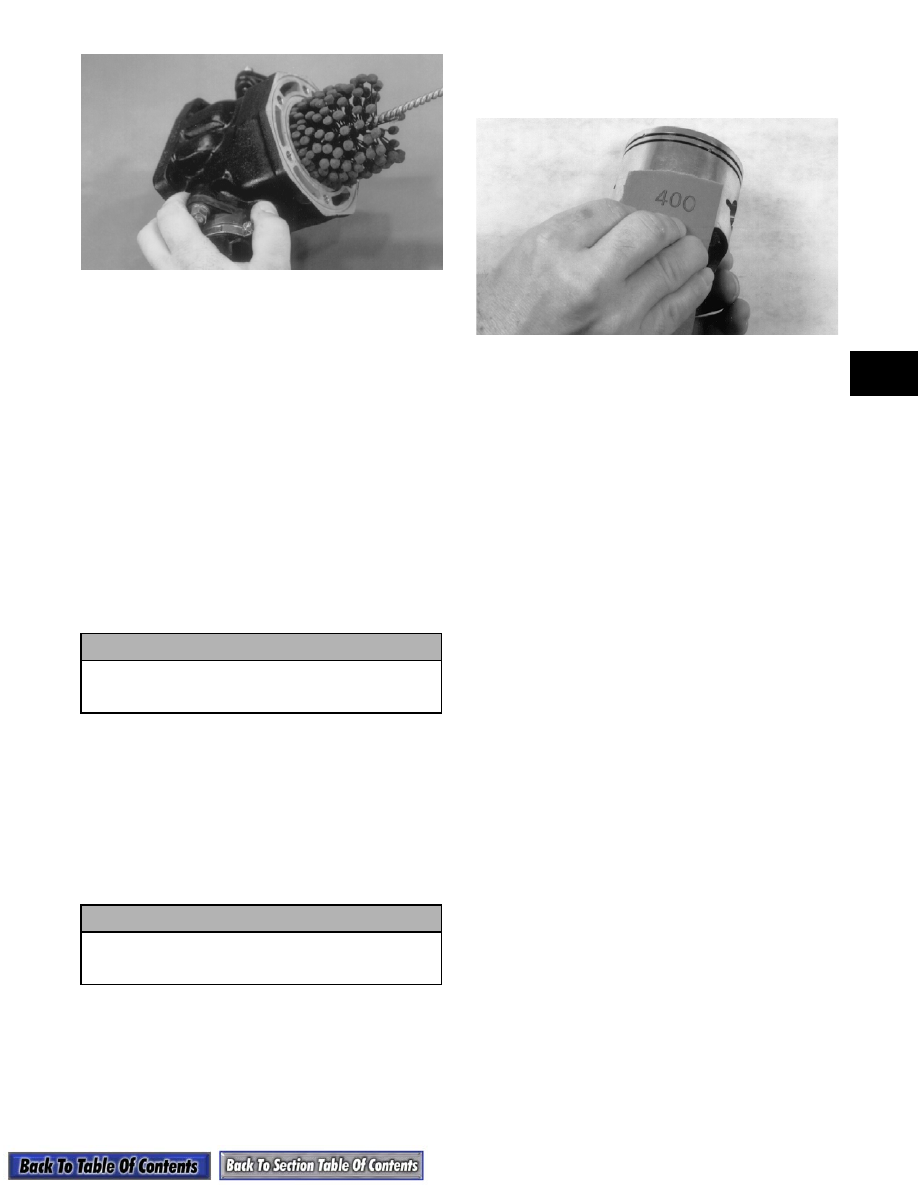Snowmobile Arctic Cat (2002 year). Manual - part 19

2-59
2
AN053
NOTE: To produce the proper 60° crosshatch
pattern, use a low RPM drill (600 RPM) at the rate
of 30 strokes per minute. If honing oil is not avail-
able, use a lightweight, petroleum-based oil. Thor-
oughly clean the cylinders after honing using
detergent soap and hot water and dry with com-
pressed air; then immediately apply oil to the cyl-
inder bores. If a bore is severely damaged or
gouged, the cylinder will have to be replaced.
4. Place the head surface of each cylinder on the
surface plate covered with #400 grit wet-or-dry
sandpaper. Using light pressure, move each
cylinder in a figure eight motion. Inspect the
surface for any indication of high spots. A high
spot can be noted by a bright metallic finish.
Correct any high spots before assembly by
continuing to move the cylinder in a figure eight
motion until a uniform bright metallic finish is
attained.
PISTON ASSEMBLY
1. Using a non-metallic carbon removal tool, remove
the carbon buildup from the dome of each piston.
2. Take an old piston ring and snap it into two pieces;
then grind the end of the old ring to a 45° angle
and to a sharp edge. Using the sharpened ring as a
tool, clean carbon from the ring-grooves. Be sure
to position the ring with its tapered side up.
3. Inspect each piston for cracks in the piston pin and
skirt areas.
4. Inspect each piston for seizure marks or scuffing.
Repair with #400 grit wet-or-dry sandpaper and
water or honing oil.
AN135
NOTE: If scuffing or seizure marks are too deep
to correct with the sandpaper, it will be necessary
to replace the piston.
5. Inspect the perimeter of each piston for signs of
excessive “blowby.” Excessive “blowby” indicates
worn piston rings or an out-of-round cylinder.
CRANKCASE
1. Wash the crankcase halves in parts-cleaning
solvent.
NOTE: Before washing the crankcase halves,
make sure the four bearing dowel pins have been
removed and accounted for.
2. Inspect the crankcase halves for scoring, pitting,
scuffing, or any imperfections in the casting.
3. Inspect all threaded areas for damaged or stripped
threads.
4. Inspect the bearing areas for cracks or excessive
bearing movement. If evidence of excessive
bearing movement is noted, repair by peening the
bearing area in a pinking (sawtooth) pattern.
5. Inspect the bearing dowel pins for wear.
6. Inspect the sealing surfaces of the crankcase
halves for trueness by placing each crankcase half
on the surface plate covered with #400 grit wet-or-
dry sandpaper. Using light pressure, move each
half in a figure eight motion. Inspect the sealing
surfaces for any indication of high spots. A high
spot can be noted by a bright metallic finish.
Correct any high spots by continuing to move the
half in a figure eight motion until a uniform bright
metallic finish is attained.
NOTE: Care must be taken not to remove an
excessive amount of aluminum, or the crankcase
will have to be replaced. If excessive aluminum is
removed, too much pre-load will be exerted on the
crankshaft bearings when assembled.
! CAUTION
Water or parts-cleaning solvent must be used in
conjunction with the wet-or-dry sandpaper or
damage to the sealing surface may result.
! CAUTION
Improper cleaning of the ring-grooves by the use
of the wrong type of ring-groove cleaner will
result in severe damage to the piston.